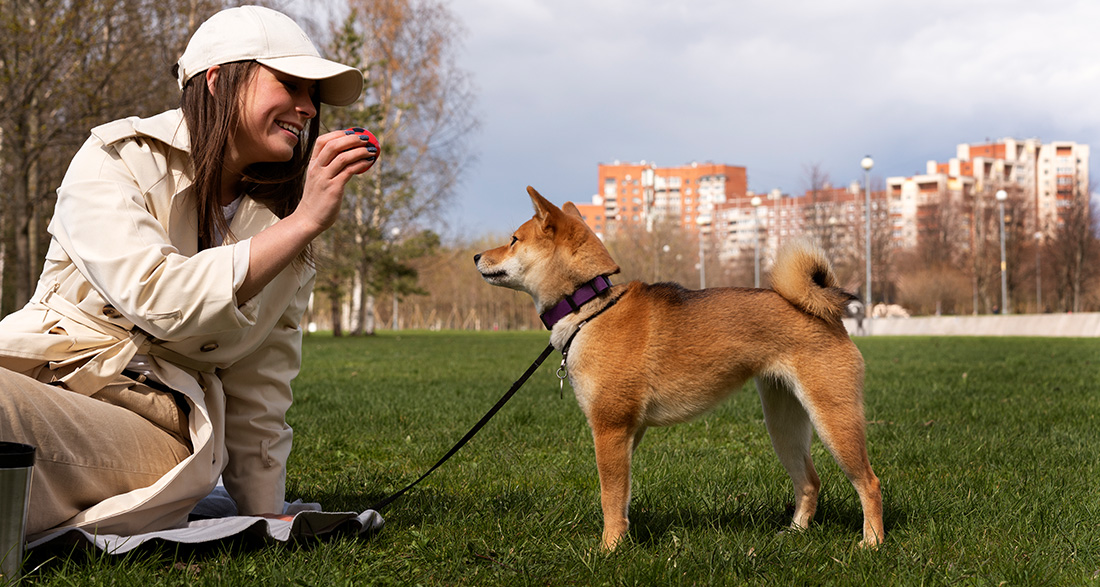When a puppy moves in with you, it needs time to acclimate to its new surroundings and get to know its new family members. At the same time, it’s important for it to quickly understand what is allowed and what is not. Therefore, you should start training immediately. Initial commands like “No” can be very helpful. But first, you should give the young dog some peace and quiet to process the separation from its littermates and provide it with security and comfort.
The First Puppy Commands – Golden Rules
For learning commands, it’s important to have the full attention of the dog.
Golden Rules:
- The puppy should not be tired or exhausted, and should not be distracted by other things during training. For this reason, it’s advisable to practice the first commands with your dog indoors in an undisturbed location.
- Also, be careful not to overwhelm the young dog so that it doesn’t build frustration during training and later lose motivation.
- Short training sessions of five minutes spread throughout the day are ideal.
- Also, beware of being too strict with the dog. Learning commands should be fun for your dog and give it a good feeling when it does something right.
- Always end the training with a success and give your furry friend some rest afterward. This way, it can process what it has learned.
The first commands you should gradually teach your little companion are “Come,” “Sit,” “Down,” and “Stay.” Once your puppy masters these commands, they will greatly ease your daily life with the dog. If you start teaching your puppy commands right after the adjustment period, you have the advantage that it is still in the socialization phase. Read more about this in the guide “Socializing Your Dog.”
Teaching Puppy Commands: Timing is Key!
When training your dog, you typically work with the principle of rewarding and ignoring. This means that desirable behavior is rewarded and undesirable behavior is ignored. You only have a time window of two seconds to positively reinforce your dog’s desired behavior or the correct execution of a command. Only immediately after the action can the dog associate the reward or praise with the action performed.
The same applies in reverse. For example, during play, there should be an immediate brief pause if the dog becomes too wild or bites too hard. If you react even a moment too late, the dog will not understand what it is being rewarded or ignored for. Therefore, proper timing is essential. To avoid overwhelming your puppy, start with simple exercises and gradually increase the difficulty level.
Teaching Puppy Commands: Types of Rewards
Usually, for the first training sessions, treats are used – specifically the type of food that your dog is really crazy about. When giving treats as rewards, it’s important to deduct the portions fed from the total food ration so that your dog is not overfed. Other types of rewards can include praise or a short play session with the favorite toy. Find out for yourself what your dog finds rewarding and vary the forms of rewards so that your furry friend is always excited about what awaits him after a command is executed correctly. Once your dog has mastered a command, you should not praise him every time after its execution. However, he should still receive a reward occasionally to maintain motivation.
Puppy Commands: The Dog’s Name is Not Included
One of the most common mistakes in dog training is using the dog’s name as a command. Your puppy’s name should always tell him, “Hey, you’re meant, pay attention to what I’m about to tell you or what you should do next!” The name of the animal is therefore used to focus its attention on the owner and is always associated with a command to be executed next: You say your dog’s name, the dog looks at you, then you give the desired command – and your puppy should execute it.
If your puppy did not have a name at the breeder’s or you want to give him a new one, you can teach him with a simple trick. Wait for a moment when the puppy is not distracted by anything else. Now, say his name in a rather high-pitched and cheerful tone. As soon as your dog looks at you, praise him immediately with enthusiasm. If you do this exercise several times a day, your dog will likely soon respond to his name every time accordingly. Once your dog knows his name, you can start practicing the first commands with him.


